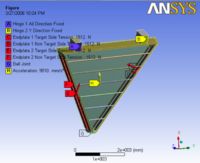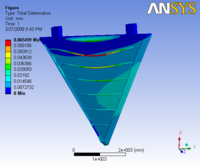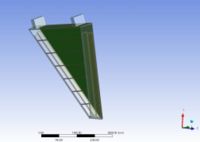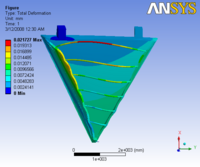Difference between revisions of "Progress reports"
| Line 64: | Line 64: | ||
| − | =4/29/08 | + | =4/29/08= |
| + | |||
| + | |||
| + | |||
[[K_4-25-08]] | [[K_4-25-08]] | ||
[http://www.iac.isu.edu/mediawiki/index.php/R3 Go back] | [http://www.iac.isu.edu/mediawiki/index.php/R3 Go back] | ||
Revision as of 19:47, 25 April 2008
R3 design Progress report
3/11/08
Progress modeling the R3 drift chamber has been held back by both software and hardware problems. This past week we installed ANSYS on a faster computer ( 2 GHz Intel with 3Meg RAM) and were able to render the design in 30 minutes instead of 2 hours. The turnaround for debugging the geometrical design is now faster and ANSY does not currently crash. We plan on doing the same test using a new computer (2 GHz Intel with 8 Meg RAM) once it has been assembled (2 weeks or less).
The image below represent the current Model which has been implemented in ANSYS.
3/18/08
1.) Movies showing deflections as a function of applying the max load and then releasing it. The max deflection is about 13 mm. The two movies below show the two endplate deflections with no rods for either 1 fixed or 2 fixed mount points.
This movie shows the endplate deflection as the wire load is applied and then released. The top two mounting brackets on the back plate are fixed.
The movie below is under similar conditions except the right bracket is allowed to move.
2.) The Max deflections decreases from 13 mm to less than 1 mm if carbon fiber rods are place along the front edge of the endplates. The back plate hinges are both fixed.
http://www.jlab.org/Hall-B/secure/clas12/RIII/ISU_Design/images/Deflection_Rods.avi
3.) The image below shows a max end plate deflection of 0.3 mm when hexcell backing sheet is used and No carbon fiber rods.
 File:Deflection Hexel 2fixedMounts.pdf
File:Deflection Hexel 2fixedMounts.pdf
4.) A max deflection of 22 microns for the carbon rods and less than 20 microns for the endplate is predicted from our current ANSYS model when both carbon fiber rods and a hexcell backing sheet are used. Only the left hinge is constrained completely and the right hinge is constrained in 2 degrees of freedom. No gravity and no differential gas pressure. Effective Youngs modulus is used. The carbon fiber rods and the hexcell backing sheet are the only materials not made from the poly foam composite. Poly foam used on endplates, back plate, and nose plate. No Al frame around endplate.
3/25/08
5) The max endplate deflection increases from 20 to less than 22 microns when gravity is added. Both the carbon fiber rods and a hexcell backing sheet are used.. The carbon rod deflection increases from 22 to 65 micron with the addition of gravity. Only the left hinge is constrained completely and the right hinge is constrained in 2 degrees of freedom. Gravity is applied along the direction from the back plate towards the Nose plate. The material properties is same as analysis 4

 Media:Deflection_with gravity_3-12-08.pdf
Media:Deflection_with gravity_3-12-08.pdf
Problems meshing 0.001 inch thick mylar sheet front window. I am able to mesh a XXXX thick sheet. So I adjust Young's Modulus accordingly.
4/14/08
The R3 design is converging to a configuration which results in a max end plate deflection less than 25 microns and more than a factor of 2 smaller than the specifications according to a three dimensional ANSYS model. The effects of gravity are included in this estimate. The impact of the differential pressure has not been included in the model. Attempts to insert a front mylar window into the model and apply a pressure were not successful. A hand calculation will be performed at this time to estimate the effects. The first estimate will consider the force exerted on the carbon rod due to the gas pressure. Is the force exerted by the mylar sheet onto the carbon rod enough to cause the rod to buckle? A second estimate will assume that the carbon rod does move and then distribute the mylar sheet load uniformly along the edges assuming the force produced by the pressure is in the same direction as the wire tension.
4/22/08
The endplate dimensions have been changed this week and were implemented. Bob Miller asked Kalyan to at the effects of the change instead of moving on to the impact of differential pressure.

